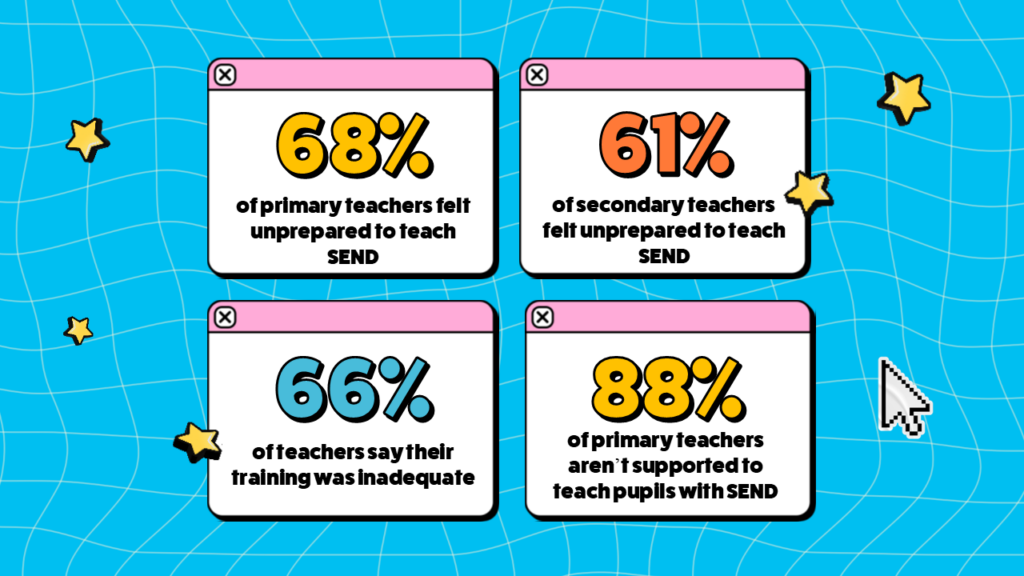If you work in education, you’re likely familiar with the SEND crisis facing schools across the country. Teachers and teaching assistants are increasingly reporting that they feel underprepared to support students with diverse needs, and many believe the system isn’t working.
In fact, a 2024 survey found that 68% of primary teachers and 61% of secondary teachers felt unprepared to teach pupils with SEND following their teacher training, which means insufficient SEND support could be major barrier to pupil learning.
So, where does the problem lie?
In this blog, we’ll explore the current landscape of SEND training and practical strategies for making a real impact in schools, featuring insights from a SEND specialist.
The Current Landscape: One Size Does Not Fit All
There are 1.7 million pupils in England with an identified special educational need (SEND), yet many teachers and TAs feel they lack the training to meet their needs effectively.

With these statistics, it’s clear that SEND training is inconsistent, underfunded, and arguably not a priority – but why?
The Problem With Current SEND Training
All teachers – whether in mainstream or special schools – will teach pupils with SEND. ITT providers do cover SEND to some extent, but the depth, quality, and practical application of training varies enormously.
Some universities offer PGCE courses with a SEND specialism, and specialist SEND teachers can gain further qualifications such as the Mandatory Qualification in Sensory Impairment (MQSI). But for some trainee teachers, the level of SEND training you receive depends on the school you are placed in and the number of pupils you teach with SEND, along with the school’s approach to CPD.
This leaves many teachers relying on trial and error, rather than evidence-based interventions. Effectively teaching pupils with SEND can therefore feel like an optional choice that few people are just ‘naturally good at’, rather than something that is an expected part of every teacher’s role.
I spoke with SEND specialist, appointed Ofsted Inspector, doctoral researcher, and neurodivergent ‘reading whisperer’ Emma Hartnell-Baker, who believes that a one-size-fits-all approach to SEND training is a major barrier to inclusion:
“This approach can inadvertently lead to a deficit-based perspective, where children are labelled as ‘having SEN’ rather than recognising and embracing the full spectrum of human diversity. Such labelling can obscure the unique strengths and potential of each student.”
So, does the whole education system need an overhaul? Or do training providers simply need to rethink their approach to SEND professional development?
Challenges in Training & Support: What’s Holding Schools Back?
A Postcode Lottery for SEND Support
A recent Education Policy Institute (EPI) report highlights “inequalities and blind spots” in SEND support across England, with the South East particularly affected. Schools in this region face:
- Lengthy EHCP delays: In Surrey, more than four in five children face long waits for Education, Health and Care Plans (EHCPs), with only 16% being issued within the 20-week statutory timeframe in 2023, leaving many children waiting for essential support.
- Underfunded SEND provision: Many schools lack resources for in-house CPD, leaving staff unprepared to support SEND pupils. A 2023 NEU survey found that 60% of teachers feel they lack the necessary SEND training. Surrey County Council currently has around 15,000 children with EHCPs, compared with 10,000 children in 2017. This is a huge increase in demand for SEND provision.
- Staffing shortages in special schools: Recruitment for SEMH and autism-specific roles remains a challenge due to a lack of specialist training.
The EPI report also suggests pupils with persistent absences and exclusions should be assessed for SEND – evidence that punitive measures like detentions are failing vulnerable learners.

Budget Constraints & Limited CPD Opportunities
Despite the Labour government’s pledge of an additional £1 billion for SEND, the lack of earmarked funds for teacher training is leaving educators underprepared.
A 2023 survey found that 63% of teachers believe insufficient SEND support is a major barrier to pupil learning – yet most receive just a few hours of SEND training in their entire initial teacher education. Schools are left to navigate rising exclusions, long EHCP delays, and increasing numbers of pupils with unmet needs without the proper training to intervene effectively.
Without mandatory, high-quality SEND CPD, this funding risks being ineffective, perpetuating a system where vulnerable pupils are excluded and left behind. If the government is serious about inclusion, it must guarantee that every teacher is trained to support SEND pupils – before more learners slip through the cracks.
Milk Academy offers a range of in-depth CPD courses for your staff across all levels to support with their teaching practice. The courses include:
- The Complete SEND Diploma (Level 2, 3, & 4)
- Learning Disabilities Awareness Certification
- Disability Awareness Certification
- Dyslexia Awareness Certification
- And more!
Training Gaps for Teaching Assistants & Support Staff
Teaching assistants play a vital role in supporting SEND students, yet they also lack access to quality training. Many TAs report feeling underprepared for working with neurodivergent learners, leading to a reliance on ad-hoc guidance rather than structured training.
However, not all teaching assistants need to come from a teaching or childcare background. Support workers and graduates from certain fields often make excellent SEND teaching assistants, due to their experience in healthcare settings or specialism in areas such as psychology, social work, or sociology.
Over-Reliance on Reactive Approaches
Rather than embedding preventative strategies, many schools are still reacting to behavioural challenges instead of proactively supporting students. Emma Hartnell-Baker believes early intervention is key:
“Preventative measures are more effective than reactive interventions. By focusing on early identification and support, we can mitigate learning difficulties before they become entrenched.”
With these challenges in mind, what realistic steps can schools take to strengthen SEND training – even with tight budgets and limited time?
Practical Strategies for Schools: Expert Advice from a SEND Specialist

Emma Hartnell-Baker, MEd SEN, experienced teacher trainer, and specialist SpLD teacher.
We know that school leaders are already stretched beyond capacity. Adding more training without meaningful support isn’t the solution. Instead, schools can take small but impactful steps to ensure SEND provision improves without overwhelming staff.
How can we bridge SEND teaching skills gaps? Emma believes “this involves equipping educators with the skills to understand and respond to each student’s unique needs, rather than conforming students to predetermined moulds.”
Here are Emma’s 4 key pieces of advice that educators and schools can start doing to provide the best possible support for pupils with SEND:
1. Embrace Individuality
Rather than focusing on deficits, begin by recognising and celebrating student strengths. Neurodivergent students often think and learn differently, not wrongly – so schools should prioritise individualised learning plans and flexible approaches.
2. Question Established Methods
Are current tools and programmes genuinely supporting linguistic development and neurodiversity?
Schools should critically assess whether existing practices actually meet the needs of their pupils. If an ADHD or autistic student learns best independently, consider how technology or self-led learning can be incorporated rather than forcing traditional teaching methods.
Emma suggests that to bridge these gaps, “it’s essential to shift from a standardised curriculum to one that prioritises personalised learning and self-teaching.”
3. Learn from Effective Practitioners
Rather than relying solely on top-down training, teachers should observe and learn from those with lived experience or proven success in SEND education. Peer mentoring, networking with specialist schools, and engaging with CPD providers that focus on real-world strategies can help bridge the gap.
4. Foster Collaborative Relationships
SEND support shouldn’t be a solo effort. Schools should work closely with colleagues, parents, and specialists to create a support network for each student.
Emma highlights the importance of engaging with neurodivergent educators who understand the system from both perspectives – as professionals and as individuals who have navigated education differently.
“As someone with AuDHD, I am rarely asked how that impacts my work with children, and the issues faced ‘fitting in’ to a system designed not only around neurotypical students but also educators.”
A Call for Change: Where Do We Go From Here?
The SEND training crisis isn’t just an issue of budget or education.
It runs deeper than that, and is arguably a reflection of how neurodivergent children are treated in society as a whole.
Every child, regardless of how they think or communicate, deserves access to trained, knowledgeable educators who can help them thrive.
Schools must be supported with better funding, training opportunities, and staffing solutions. At Milk Education, we work closely with schools to:
- Connect them with passionate SEND educators.
- Provide specialist CPD through Milk Academy.
- Support schools in utilising graduates and TAs in SEND roles.
What do you think needs to change in SEND training? Join the discussion on LinkedIn.

